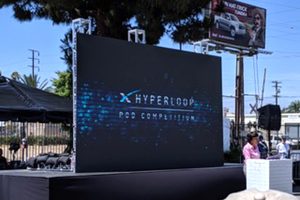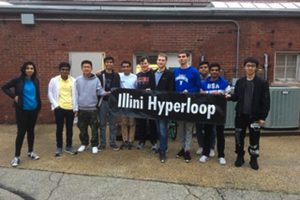Imagine traveling from Champaign to Chicago in 15 minutes at upwards of 700 mph in a pod running through a vacuum tube. This seems impossible when thinking about the speeds we can travel now in cars, planes, and even advanced maglev (magnetic levitation) trains; however, the hyperloop is trying to break these travel barriers. 
Elon Musk — CEO of Tesla and SpaceX — piloted this program after California proposed a high-speed rail network that would be one of the most expensive and slowest around.
Part of piloting this program involves holding a hyperloop pod competition in Hawthorne, Calif., where 21 student teams from all over the world are invited to showcase and test their pods.
One of these 21 teams is our very own Illini Hyperloop, a part of the Midwest Hyperloop coalition that consists of teams from Illinois, Purdue University, and the University of Cincinnati. Each team has its own individual expertise, and they all complement one another to build a single vehicle.
 Illini Hyperloop President Brian Bailey said the competition is about coming together as a community to share ideas and advance hyperloop technology.
Illini Hyperloop President Brian Bailey said the competition is about coming together as a community to share ideas and advance hyperloop technology.
“While our vehicles may run in a vacuum, we understand that our ideas can’t stay in a vacuum if we are to make a difference,” Bailey said.
There is never a shortage of innovative ideas when it comes to the design, but the team works hard to converge at a design that is both innovative and practical. Once team members have a plan, they get to work modeling the design in SolidWorks. From there, the team uses a software called ANSYS to run simulations on their vehicle.
“It’s not enough to have a good design in this competition,” Bailey said. “Every system needs to be validated to verify it will function correctly and safely.”
In addition to the mechanical side of the design, the team also builds all the electronics and software to bring the vehicle to life. The software team focuses on running the motor, figuring out where they are in the tube, then braking at the appropriate time. They take in data from upwards of 100 sensors, then figure
out what that means for the state of the vehicle and what the appropriate action to take is.
The Emrax electric motor that the team uses is up to 98% efficient, while gas combustion engines are typically only about 20% efficient, according to the EMRAX 228 Technical Data Summary.
Finally, the electronics team focuses on high-voltage electronics and chooses the right batteries and motor controller for its application. 
Said Bailey: “Our vehicle can put out a lot of power. Our batteries have a maximum output of around 100 kilowatts and handling that power safely is no small task.”
Anshul Shah, the software lead of Illini Hyperloop, said energy efficiency is one of the most important features when it comes to incorporating sustainability.
“The key is that is wastes a lot less energy, so not only does its increase the speed of transport, but it reduces the cost of transport and it is very energy efficient,” Shah said.
This increase in efficiency is because the vehicle is fully electric. Additional efficiency is achieved by removing all air from the tube so that there is no air resistance holding the vehicle back.
Not only that, but simply constructing and building the hyperloop could be impactful on the environment.
“One of the most impactful features may be the turning the mud from the tunnel into structural bricks that could potentially be used for the tunnel walls — and excess bricks can be sold as a substitute for concrete. This matters “since concrete production accounts for 4.5% of the world’s greenhouse gas emissions” and the mud is typically just trucked away. So this turns a liability into an asset,” Bailey said.
Because of the popularization of the hyperloop concept by Musk — and because of students who work hard on perfecting running such an innovative idea — the future for high-speed and environmentally friendly travel looks good.
Although the hyperloop competition only lasts for one week out of the summer, the sustainability outcomes could last a lifetime.
— Article by Chloe Rice, iSEE Communications Intern; Images provided by Illini Hyperloop
